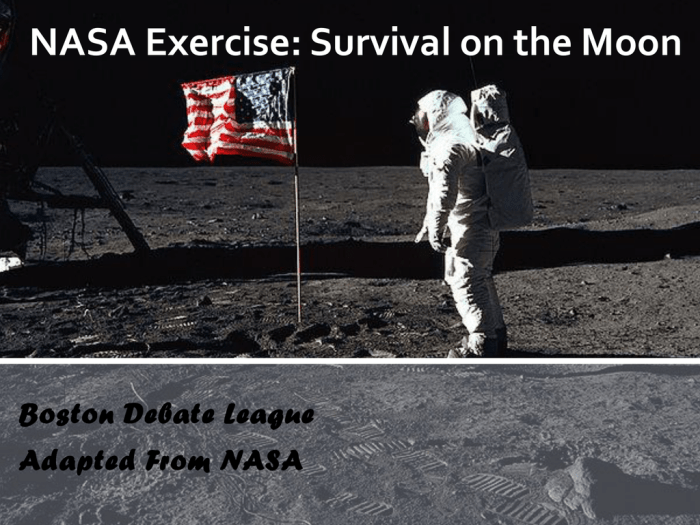Nasa survival on the moon exercise – NASA’s survival exercises on the Moon, a critical aspect of lunar exploration, have played a pivotal role in developing technologies and techniques for human survival in the harsh lunar environment. These exercises, conducted over several decades, have tested life support systems, explored lunar resources, and evaluated human performance, paving the way for future missions to the Moon.
The objectives of these survival exercises have been multifaceted, including testing life support systems, evaluating human performance, and exploring lunar resources. The exercises have involved rigorous training programs, specialized equipment, and simulation facilities to prepare astronauts for the challenges of lunar missions.
Historical Context: Nasa Survival On The Moon Exercise

NASA’s survival exercises on the Moon began in the early 1960s as part of the Apollo program. The first exercise, known as the Apollo Lunar Surface Experiment Package (ALSEP), was deployed on the Moon by the Apollo 11 crew in 1969. ALSEP consisted of a series of instruments that were designed to collect data on the lunar environment and to test the feasibility of long-term human habitation on the Moon.
Mission Objectives
The primary goals of the survival exercises on the Moon were to test life support systems, explore lunar resources, and evaluate human performance in the lunar environment. Specific tasks and experiments conducted during these exercises included:
- Testing the Apollo Lunar Module’s life support systems, including the environmental control system, water recycling system, and food storage system.
- Exploring lunar resources, such as water ice and minerals, and assessing their potential for use in future lunar missions.
- Evaluating human performance in the lunar environment, including the effects of radiation, extreme temperatures, and lack of atmosphere.
Equipment and Technologies
The specialized equipment and technologies developed for survival on the Moon included:
- The Apollo Lunar Module, which provided a pressurized living and working environment for the astronauts.
- The Apollo spacesuits, which protected the astronauts from the harsh lunar environment.
- The Lunar Roving Vehicle, which allowed the astronauts to explore the lunar surface.
- The ALSEP, which collected data on the lunar environment and tested the feasibility of long-term human habitation on the Moon.
Crew Selection and Training, Nasa survival on the moon exercise
The astronauts selected for survival exercises on the Moon were highly trained and experienced pilots and engineers. They underwent rigorous training programs that prepared them for the physical and psychological demands of lunar missions. The training programs included:
- Physical training to prepare the astronauts for the rigors of space travel, including weightlessness, radiation, and extreme temperatures.
- Psychological training to prepare the astronauts for the isolation and stress of long-term space missions.
- Mission-specific training to prepare the astronauts for the specific tasks and experiments that they would be conducting on the Moon.
Simulation and Testing
Before actual lunar missions, NASA used simulation facilities to test survival techniques and equipment. These facilities included:
- The Lunar Module Simulator, which was used to train astronauts on the operation of the Apollo Lunar Module.
- The Neutral Buoyancy Laboratory, which was used to train astronauts on spacewalks in a simulated lunar environment.
- The Virtual Reality Lunar Environment Simulator, which was used to train astronauts on the operation of lunar rovers and other equipment in a simulated lunar environment.
Data Analysis and Findings
Data collected during survival exercises on the Moon was analyzed to improve survival techniques and technologies. Key findings from these exercises included:
- The Apollo Lunar Module’s life support systems were able to sustain astronauts for extended periods of time in the lunar environment.
- Lunar resources, such as water ice and minerals, could be used to support future lunar missions.
- Human performance in the lunar environment was affected by radiation, extreme temperatures, and lack of atmosphere, but these effects could be mitigated with proper training and equipment.
International Collaboration
NASA’s survival exercises on the Moon involved collaboration with other space agencies, including the European Space Agency (ESA) and the Russian Federal Space Agency (Roscosmos). This collaboration allowed NASA to share knowledge and resources with other countries and to develop common standards for lunar exploration.
Future Prospects
The survival techniques and technologies developed for the Moon have applications in other space exploration missions. For example, the life support systems developed for the Apollo Lunar Module are being used in the International Space Station. The Lunar Roving Vehicle is being used as a model for future lunar rovers.
And the ALSEP is being used to collect data on the Martian environment.
FAQ Corner
What is the primary goal of NASA’s survival exercises on the Moon?
The primary goal is to test and refine technologies and techniques for human survival on the Moon, including life support systems, resource utilization, and human performance evaluation.
How do these exercises contribute to future lunar missions?
The findings from these exercises provide valuable insights into the challenges of lunar survival and inform the design and development of future lunar missions, ensuring the safety and success of astronauts.
What are some of the key technologies developed through these exercises?
These exercises have led to the development of specialized equipment and technologies for lunar survival, such as advanced life support systems, lunar resource extraction techniques, and radiation shielding technologies.
